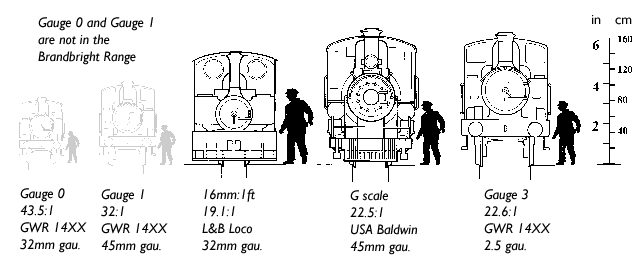Page 1 of 1
Is 'O' gauge the same as 32mm gauge?
Posted: Sun Dec 01, 2013 7:38 pm
by Woodfields Light Railway
Gauges and scale. I'm confused
Posted: Sun Dec 01, 2013 7:43 pm
by DolwyddelanLightRail
I wouldn't worry, it took me a while to get used to the two scales.
O gauge and SM32 are both the same gauge (32mm). O gauge is Finescale O gauge and is represented by 7mm to the foot, and SM32 is Narrow Gauge O Gauge, and is represented by 16mm to the foot. So this means in scale terms that the Finescale track is aimed at Standard Gauge models which in term have smaller locomotives and stock in comparison with SM32 which put to scale has much larger track to represent narrow gauge and thus the locomotives are larger.
Hope that makes sense!
Posted: Sun Dec 01, 2013 7:47 pm
by Woodfields Light Railway
Errrrrr, if you were to perchase a o gauge loco and stock, would it fit on sm 32 track? Sorry, you probably have answered that question al ready, but I am a newbie to this garden railway melarky
Posted: Sun Dec 01, 2013 8:09 pm
by jay1976
yes 0 gauge stock will go on sm32 track,but most sm32 wont go on normal 0 gauge track as the wheel flange(the bit which keeps the wheels on the track) are much deeper than 0 gauge stock,sm32 stock will hit the sleepers on ) gauge track...
I got a few 0 gauge rolling stock which i run on my test track ok(I have no permanant railway yet just a test track)
Posted: Sun Dec 01, 2013 10:34 pm
by steamie1
Watch the points, there is issues with running an O gauge loco on SM32 track.
Posted: Mon Dec 02, 2013 12:01 am
by andymctractor
Scale and gauge are often referred to as one and the same thing but they are not. Quite often a letter is followed by the word 'gauge' when it would be more correct to say 'scale'. E.g. O gauge. This would be more correct to be called O scale.
Simply, scale is the size of a model in relation to the real thing and in railway modelling circles is often described as a dimension in mm on the model to a foot on the real thing.
E.g. 'O' is 7mm to ft OR 7mm on the model representing 1 ft of the real thing. But this is often called O gauge rather than O scale and this understandably causes confusion and would be recognised as wrong if it were not so widely accepted.
Another scale is 16mm/ft which is the scale that many 16mm narrow gauge modellers use. This means that 16mm on the model represents 1 ft on the real thing.
So we've looked briefly at scale.
Gauge is only the distance between the rails, and models with the same gauge may be different scales and this brings us to 32mm gauge track. O gauge, which we now know should be called O scale is 7mm/ft scale but uses 32mm gauge track. 16mm/ft modellers mostly use 32 mm gauge track also. However the O scale track is to a different scale to 16mm/ft scale track although they are both 32 mm gauge.
Clearly with the same gauge track some O models will run on the same track as some 16 mm models and vice versa. The best way to understand this is to look at a two pieces of track side by side from each of these scales.
The issue of gauge and scale gets very much more confusing in railway modelling when different scales of model are described with a variety of gauges when modelling the variety of gauges on the prototype railways.
Hope this helps.
Posted: Mon Dec 02, 2013 3:19 am
by Chris Cairns
As the above replies prove there is no one definitive answer. I like this definition -
Scale refers to the size of the model relative to the actual full-sized object being represented, while gauge is the width of the model track. Most commercially produced model track is a compromise between appearance and a trouble-free running surface.
Brandbright have a section on their website although the image (below) seems to be no longer available -
http://www.brandbright.co.uk/information.php?info_id=7

Where I get annoyed is when model figures are listed as 16mm/G scale without their actual physical size - they cannot represent the same full size figure in both scales. I picked up one of the free 16mm scale rulers that Mike Johnson (Jurassic Models) has available at trade shows - ideal for visits to the £1 stores for cheap figures & toys that can be adapted for our purpose (the latest Star Trek Galaxy Collection figures are ideal for 16mm scale purposes).
Chris Cairns.
Posted: Mon Dec 02, 2013 12:42 pm
by Peter L
You may also find this page useful:
http://www.carendt.com/articles/scaleguide.html - a list of many (but not all!) scale/gauge combinations and what they represent
Posted: Mon Dec 02, 2013 7:58 pm
by tom_tom_go
The Peco track catalogue also have a great guide on scale/gauges.
Posted: Fri Dec 20, 2013 6:33 pm
by Woodfields Light Railway
Okay, now that's sorted, Is gauge 1 the same as 45mm?
Posted: Fri Dec 20, 2013 6:36 pm
by Dr. Bond of the DVLR
Guage 1 refers to a scale of 1:32 or 10mm to the foot running on 45mm gauge to represent standard gauge.
45mm gauge is also commonly used by 16mm scalers to represent 2ft 9 and 3/4 inch gauge, 15mm scalers to represent 3ft gauge and G scalers to represent some funny metric gauge of some sort...
Posted: Fri Dec 20, 2013 6:38 pm
by Woodfields Light Railway
Great, thanks. Merry Christmas Mr Bond!
